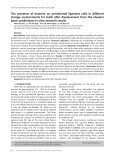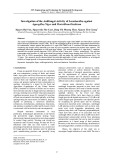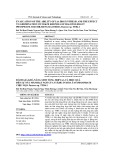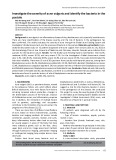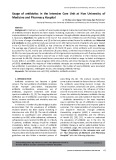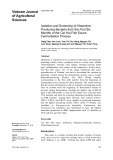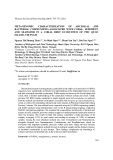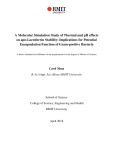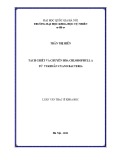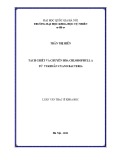doi:10.1046/j.1432-1033.2003.03520.x
Eur. J. Biochem. 270, 1555–1566 (2003) (cid:2) FEBS 2003
Oxygen control of nif gene expression in Klebsiellapneumoniae depends on NifL reduction at the cytoplasmic membrane by electrons derived from the reduced quinone pool
Roman Grabbe and Ruth A. Schmitz
Institut fu¨r Mikrobiologie und Genetik, Georg-August Universita¨t Go¨ttingen, Germany
heterologous Escherichia coli system carrying a ndh null allele (coding for NADH dehydrogenaseII). Second, study- ing nif-induction in K. pneumoniae revealed that during anaerobic growth in glycerol, under nitrogen-limitation, the presence of the terminal electron acceptor nitrate resulted in a significant decrease of nif-induction. The final line of evi- dence is that reduced quinone derivatives, dimethyl- naphthoquinol and menadiol, are able to transfer electrons to the FAD-moiety of purified NifL. On the basis of these data, we postulate that under anaerobic and nitrogen-limited conditions, NifL inhibition of NifA activity is relieved by reduction of the FAD-cofactor by electrons derived from the reduced quinone pool, generated by anaerobic respiration, that favours membrane association of NifL. We further hypothesize that the quinol/quinone ratio is important for providing the signal to NifL.
Keywords: Klebsiella pneumoniae; nitrogen fixation; NifL; FNR; quinol/quinone ratio.
In Klebsiella pneumoniae, the flavoprotein, NifL regulates NifA mediated transcriptional activation of the N2-fixation (nif) genes in response to molecular O2 and ammonium. We investigated the influence of membrane-bound oxidoreduc- tases on nif-regulation by biochemical analysis of purified NifL and by monitoring NifA-mediated expression of nifH¢- ¢lacZ reporter fusions in different mutant backgrounds. NifL-bound FAD-cofactor was reduced by NADH only in the presence of a redox-mediator or inside-out vesicles derived from anaerobically grown K. pneumoniae cells, indicating that in vivo NifL is reduced by electrons derived from membrane-bound oxidoreductases of the anaerobic respiratory chain. This mechanism is further supported by three lines of evidence: First, K. pneumoniae strains carrying null mutations of fdnG or nuoCD showed significantly reduced nif-induction under derepressing conditions, indi- cating that NifL inhibition of NifA was not relieved in the absence of formate dehydrogenase-N or NADH:ubiqui- none oxidoreductase. The same effect was observed in a
In the free-living diazotrophs, Klebsiella pneumoniae and Azotobacter vinelandii, members of the c-subgroup of proteobacteria, N2-fixation is controlled tightly to avoid unnecessary consumption of energy. The transcriptional activator, NifA and the inhibitor, NifL regulate the transcription of the N2-fixation (nif ) operons according to the environmental signals, ammonium and O2 (reviewed in [1,2]). Under O2 and nitrogen-limitation, the inhibitor, NifL stays in a noninhibitory conformation and nif-gene expres- sion is activated by NifA. In the presence of O2 or ammonium, NifL antagonizes the activity of NifA resulting
in a decrease of nif-gene expression. In K. pneumoniae, the translationally coupled synthesis of nifL and nifA, in addition to evidence from immunological studies of complex formation, imply that the inhibition of NifA activity by NifL occurs via a direct protein–protein interaction [3,4]. For the diazotroph A. vinelandii, the formation of NifL–NifA com- plexes has been demonstrated recently by in vitro co- chromatography and by using the yeast two-hybrid system [5–7]. Recent studies revealed that the nitrogen signal in K. pneumoniae and A. vinelandii act on the downstream regulatory proteins, NifL and NifA, via the GlnK protein (a paralogue PII-protein). However, the mechanism appears to be opposite in K. pneumoniae and A. vinelandii. In K. pneu- moniae, relief of NifL inhibition under nitrogen-limiting conditions depends on the presence of GlnK, the uridyly- lation state of which appears not to be essential for its nitrogen signaling function [8–11]. However, it is currently not known whether GlnK interacts with NifL or NifA alone, or affects the NifL/NifA-complex. In contrast to K. pneu- moniae, nonuridylylated GlnK protein appears to activate the inhibitory function of A. vinelandii NifL under nitrogen excess, whereas under nitrogen-limitation the inhibitory activity of NifL is apparently relieved by elevated levels of 2-oxoglutarate [12,13]. Interactions between A. vinelandii GlnK and NifL were demonstrated recently using the yeast two-hybrid system and in vitro studies further indicated that
Correspondence to R. A. Schmitz, Institut fu¨ r Mikrobiologie und Genetik, Georg-August Universita¨ t Go¨ ttingen, Go¨ ttingen, Germany. Fax: + 49 551 393808, Tel.: + 49 551 393796, E-mail: rschmit@gwdg.de Abbreviations: NAD, nicotinamide adenine dinucleotide; FAD, flavin adenine dinucleotide. Enzymes: Formate dehydrogenase-N (EC 1.2.1.2), fumarate reductase (EC 1.3.5.1), nitrate reductase (EC 1.7.99.4), NADH:ubiquinone oxidoreductase (NADH dehydrogenase I) (EC 1.6.5.3), NADH dehydrogenase II (EC 1.6.99.3). (Received 18 September 2002, revised 11 December 2002, accepted 31 January 2003)
1556 R. Grabbe and R. A. Schmitz (Eur. J. Biochem. 270)
(cid:2) FEBS 2003
Gal r ] [26] were provided by G. Roberts (Madison, Wisconsin, USA). The spontaneous streptomycin resistant UN4495 strain, RAS46, carrying a rpsL mutation was isolated by plating UN4495 on a Luria–Bertani (LB) agar plate containing 100 lg streptomycin per ml. K. pneumoniae ssp. pneumoniae (DSM no. 4799, not N2-fixing) and K. oxytoca (DSM no. 4798, not N2-fixing) were obtained from the Deutsche Sammlung von Mikroorganismen und Zellkulturen GmbH (Braunschweig, Germany).
In general, mutant strains of the streptomycin resistant K. pneumoniae UN4495 strain (RAS46) were constructed using the allelic exchange system developed by Skorupsky and Taylor [27]. The respective genes were cloned by PCR- techniques, a tetracycline-resistance cassette (derived from the MiniTn5 [28]) was inserted and the resulting interrupted genes were cloned into the suicide vector, pKAS46. These constructs were then introduced into the chromosome of RAS46 by side-specific recombination. The respective chromosomal mutations were confirmed by PCR and Southern blot analysis [29]. For generation of homologous primers for PCR amplification, sequence information for genes of K. pneumoniae MG478578 (ssp. pneumoniae, not N2-fixing) was obtained from the database of the Genome Sequencing Center, Washington University, St. Louis (Genome Sequencing Center, personal communication) and using the database, ERGO (Integrated Genomics, Inc.; http://www.integratedgenomics.com).
the nonuridylylated form of A. vinelandii GlnK interacts directly with NifL and prevents nif-gene expression [14,15]. For the O2-signaling pathway, it was shown that A. vin- elandii NifL and K. pneumoniae NifL act as redox-sensitive regulatory proteins. NifL appears to modulate NifA activity in response to the redox-state of its N-terminal bound FAD- cofactor, and only allows NifA activity in the absence of O2, when the flavin cofactor is reduced [16–19]. Thus, under anaerobic conditions in the absence of ammonium, reduc- tion of the flavin moiety of NifL is required to relieve NifL inhibition of NifA. Recently, we have demonstrated that in K. pneumoniae the global regulator, FNR is required to mediate the signal of anaerobiosis to NifL [20]. We proposed that in the absence of O2, the primary O2 sensor, FNR, activates transcription of gene(s) the product(s) of which reduce the NifL-bound FAD-cofactor. Localization ana- lyses under various growth conditions further showed that NifL is highly membrane-associated under depressing conditions, thus, impairing the inhibition of cytoplasmic NifA [21]. Upon a shift to aerobic conditions or nitrogen sufficiency, however, NifL dissociates into the cytoplasm [21]. This indicates that sequestration of NifL to the cytoplasmic membrane under anaerobic and nitrogen- limited conditions appears to be the mechanism for regu- lation of NifA activity by NifL. Based on these findings, the question arises whether NifL reduction occurs at the cyto- plasmic membrane by an oxidoreductase of the anaerobic respiratory chain and favours membrane association of NifL.
In order to verify this hypothesis and to identify the electron donor – potentially localized in the cytoplasmic membrane – we (a) studied in vitro reduction of purified NifL using artificial electron donors or NADH and (b) analyzed the effect on nif-regulation of different membrane- bound oxidoreductases of the anaerobic respiratory chain and of terminal electron acceptors under fermentative growth conditions. Unexpectedly, during these studies we revealed that the anaerobic metabolism in E. coli and K. pneumoniae differ significantly in various aspects.
Materials and methods
The bacterial strains and plasmids used in this study are listed in Table 1. Plasmid DNA was transformed into E. coli cells according to the method of Inoue et al. [22] and into K. pneumoniae cells by electroporation. Transduction by phage P1 was performed as described previously [23].
E.colistrains
nuoCD mutant. RAS47 was constructed as follows (a) a 1.6-kb fragment carrying the nuoCD genes of K. pneumo- niae M5a1 was amplified by PCR using primers with additional synthetic restriction recognition sites (lower case letters) nuoC/D ERI (5¢-CAGCGCgaattcTCGCCGGCA- 3¢) and primer nuoC/D HindIII (5¢-CTGCTGaagcttG CGCAGACTCTG-3¢) and cloned into pBluescript SK+ producing pRS191; (b) a 2.2-kb fragment containing the tetracycline resistance cassette [28] was inserted into the EcoRV site of nuoCD gene region in pRS191 yielding pRS194; (c) the 3.8-kb EcoRI/KpnI fragment of pRS191 carrying the interrupted nuoCD region was transferred into the allelic exchange vector, pKAS46 [27] creating plasmid, pRS197; (d) pRS197 was transformed into RAS46 and recombinant strains carrying the chromosomally inserted plasmid (by means of single homologous recombination) were identified by their resistance to tetracycline and their inability to grow on streptomycin agar plates as a the plasmid encoded rpsL mutation. consequence of Overnight selection in liquid LB medium containing 400 lg streptomycin per ml and subsequent selection of single colonies onto plates resulted in loss of the integrated plasmid with an integration frequency of the interrupted nuoCD region in 50% of the integrants.
respectively,
E. coli NCM1529, containing a chromosomal nifH¢-lacZ¢ fusion [24], was chosen to study NifA and NifL regulation in E. coli. The ndhII::tet allele and frdABCD::tet allele were transferred from ANN001 (T. Friedrich, unpublished observation) and from JI222 [25], into NCM1529 by P1-mediated transduction with selection for tetracycline resistance, resulting in RAS50.
K.pneumoniae strains
fdnG mutant. Primer, fdnG 5¢-EcoRI (5¢-CCGACTGAT gaattcCGACCGCGA-3¢) and primer fdnG 3¢-HindIII (5¢-GCCGAGCAGaagcttGATCATCGC-3¢) were used to clone a 1-kb fdnG fragment from K. pneumoniae M5a1 into pBSK+ vector creating pRS167, followed by insertion of the tetracycline resistance cassette into the EcoRV site of fdnG fragment resulting in pRS177. The 3.2-kb EcoRI/KpnI fragment of pRS177 including the fdnG::tet region the was cloned into pKAS46. The construction of
K. pneumoniae strain, M5al (wild- type, N2-fixing) and strain, UN4495 [/(nifK-lacZ)5935 Dlac-4001 hi D4226
NifL reduction at the cytoplasmic membrane (Eur. J. Biochem. 270) 1557
(cid:2) FEBS 2003
Table 1. Bacterial strains and plasmids used in this study.
Strain or plasmid Relevant genotype Source/reference
K. pneumoniae
M5a1 UN4495 subs. pneumoniae
Wild-type / (nifK-lacZ)5935 Dlac-4001 hi D4226 Galr Wild-type, not N2-fixing Wild-type, not N2-fixing UN4495, but fnr::W UN4495, but spontaneous streptomycin resistance UN4495, but nuoCD::tet UN4495, but fdnG::tet [26] [26] DSM number 4799 DSM number 4798 [20] This study This study This study K. oxytoca RAS18 RAS46 RAS47 RAS48 E. coli [8] NCM1529
araD139D(argF-lacU)169 fthD5301 gyrA219 non9 rspL150 ptsF25 0 relA1 deoC1 trpDC700putPA1303::[Kanr-(nifH-lacZ)] (Wild-type) NCM1529/pNH3 NCM1529/pJES851 NCM1529, but ndh::tet RAS50/pNH3 RAS50/pJES851 NCM1529, but frd::tet RAS53/pNH3 RAS53/pJES851 [8] [8] This study This study This study This study This study This study
chromosomal mutant was performed as described above, yielding RAS48.
In E. coli strains carrying a plasmid encoding NifL and NifA (pNH3) or NifA alone (pJES851) expression of nifLA or nifA from the tac promoter was induced by the addition of 10 lM isopropyl-b-D-thiogalactopyranoside (IPTG).
Growth conditions
b-Galactosidase assay
NifA-mediated activation of transcription from the nifHDK promoter in K. pneumoniae UN4495 and E. coli strains was monitored by measuring the differential rate of b-galactosi- dase synthesis during exponential growth (units per ml per cell turbidity at 600 nm [D600] [30]). Inhibitory effects of NifL on NifA activity in response to ammonium and O2 were assessed by virtue of a decrease in nifH expression.
Purification of MBP-NifL
induction medium [32]
In E. coli and K. pneumoniae strains carrying chromosomal nifH¢-lacZ¢ fusions, nif gene expression (synthesis of nitro- genase) can be monitored by NifA activity. Cultures were grown anaerobically with N2 as the gas phase at 30 (cid:3)C in minimal medium, supplemented with 4 mM glutamine as the sole (limiting) nitrogen source, that allows full induction of nif gene expression as shown recently [17,20,30]. The medium was further supplemented with 10 mM Na2CO3, 0.3 mM sulfide and 0.002% resazurin to monitor anaero- biosis, and 0.4% sucrose plus 0.004% histidine for K. pneu- moniae strains and 1% glucose plus 0.002% tryptophane for E. coli strains. Precultures were grown overnight in closed bottles in the same medium but lacking sulfide and resazurin and with N2 as the gas phase. Main cultures (25 mL) were inoculated from precultures and incubated under a N2 atmosphere and strictly anaerobic conditions without shaking. Anaerobic samples were taken for monitoring of growth at 600 nm and b-galactosidase activity determined.
The fusion protein between maltose binding protein (MBP) and NifL was synthesized in NCM1529, carrying the plasmid pJES794 [31], grown aerobically at 30 (cid:3)C in maximal supplemented with 0.5 mM riboflavin. Expression of the fusion protein was induced with 100 lM IPTG when cultures reached a
cloning vector Topo-TA cloning vector allelic exchange vector, oriR6K; rpsL*(Streps), Ampr, Kanr K. pneumoniae nifLA under the control of the tac promoter K. pneumoniae nifA under the control of tac promoter K. pneumoniae malE-nifL under the control of the tac promoter EcoRI/HindIII fdnG fragment (K. pneumoniae M5a1) in pBSK+ pRS167, but fdnG::tet frdA fragment (K. pneumoniae M5a1) in pCR2.1 EcoRI/HindIII nuoCD fragment (K. pneumoniae M5a1) in pBSK+ fdnG::tet fragment from pRS177 in pKAS46 pRS191, but nuoCD::tet nuoCD::tet fragment from pRS194 in pKAS46 Stratagene Invitrogen [27] [4] [30] [31] This study This study This study This study This study This study This study NCM1528 NCM1527 RAS50 RAS51 RAS52 RAS53 RAS54 RAS55 Plasmids pBSK+ pCR 2.1 pKAS46 pNH3 pJES851 pJES794 pRS167 pRS177 pRS187 pRS191 pRS193 pRS194 pRS197
1558 R. Grabbe and R. A. Schmitz (Eur. J. Biochem. 270)
(cid:2) FEBS 2003
was determined as described by Friedrich et al. [35] using ferricyanide as an electron acceptor. The assay contained vesicle buffer (10 mM Tris/HCl pH 7.5, 50 mM KCl, 2 mM dithiothreitol), 0.3 mM NADH and 0.2 mM potassium ferricyanide. The reaction was started with the addition of cell extract and the decrease of the A410 value reflecting reduction of ferricyanide by NADH was monitored.
Southern blot analysis
turbidity of 0.6 at 600 nm. After harvesting and disruption in B buffer (20 mM Epps (N-[2-hydroxyethyl]piperazine-N¢- 3-propanesulfonic acid), 125 mM potassium glutamate, 5% glycerol, 1.5 mM dithiothreitol, pH 8.0) using a French pressure cell, cell debris was sedimented by centrifugation at 20 000 g for 30 min and the fusion protein was purified from the supernatant by amylose affinity chromatography. All purification steps were performed at 4 (cid:3)C in the dark, preventing degradation of the FAD moiety. The purified protein was dialyzed overnight into B buffer containing 25 mM potassium glutamate and used subsequently for biochemical analysis. The amount of FAD cofactor of the NifL fractions was calculated using a UV/Visual spectrum at 450 nm and the extinction coefficient )1Æcm)1 [33] and was in the range of 2450 ¼ 11.3 mM 0.4–0.6 mol FAD per mol MBP-NifL.
Spectral analysis of purified MBP-NifL
Southern blots were performed as described by Sambrook et al. [29], hybridization with DIG-labeled probes and chemiluminescent detection using CSPD was carried out according to the protocol of the manufacturer (Boehringer, Germany). In order to identify potential ndh genes in Klebsiella strains, Southern blot analysis was performed using a ndh probe derived from K. pneumoniae ssp. pneu- moniae and SmaI digested chromosomal DNA derived from K. pneumoniae M5a1, K. oxytoca and K. pneumoniae ssp. pneumoniae as control.
Western blot analysis
Samples (1 mL) of exponentially growing cultures were harvested and concentrated 20-fold SDS gel-loading buffer [36]. Samples were separated by SDS/PAGE (12% gel) and transferred to nitrocellulose membranes as described previ- ously [29]. Membranes were exposed to polyclonal rabbit antisera directed against the NifL or NifA proteins of K. pneumoniae, protein bands were detected with secondary antibodies directed against rabbit IgG and coupled to horseradish peroxidase (Bio-Rad Laboratories). Purified NifA and NifL from K. pneumoniae were used as standards.
Membrane preparation
Purified MBP-NifL was reduced at room temperature under a N2 atmosphere in the presence of NADH and methyl viologen. The standard 0.2 mL assay was performed in B buffer (25 mM potassium glutamate, pH 8.0) under a N2 atmosphere using 10–40 lM MBP-NifL. Reduction of fully oxidized MBP-NifL was followed using a spectro- photometer with an integrated diode array detector (J & M Analytische Meb- und Regeltechnik, Aalen, Germany). NADH (final concentration, 1.25 mM) was used as a reductant in the presence of 0.2 lM methyl viologen or inverted vesicles (10 mgÆmL)1) derived from K. pneumoniae cells grown under anaerobic conditions and nitrogen- limitation. Reduced soluble quinone derivatives, dimethyl- naphthoquinol (DMNH2) and menadiol (MDH2) (0.12 mM final concentration), were used in the absence of a redox mediator. Stock solutions of DMN and MD were prepared in ethanol. After dilution into anaerobic B buffer containing 25 mM potassium glutamate, DMN and MD were reduced by molecular hydrogen in the gas phase in the presence of platin oxide and the reduction was confirmed by monitoring the changes in absorbance at 270 and 290 nm (DMN) or 280 and 320 nm (MD).
Preparation of inside-out vesicles of K.pneumoniae
Cytoplasmic and membrane fractions of K. pneumo- niae UN4495 and mutant derivatives were separated by several centrifugation steps as recently described by Klopprogge et al. [21]. The NifL bands of cytoplasmic and membrane fractions were visualized in Western blot analyses using the ECLplus system (Amersham Pharmacia) with a fluoroimager (Storm, Molecular Dynamics). The protein bands were quantified for each growth condition in three independent membrane preparations using the IMAGEQUANT v1.2 software (Molecular Dynamics) and known amounts of the respective purified proteins.
Results
Our goal was to identify the physiological electron donor of K. pneumoniae NifL and its localization in the cell. Thus, we studied the reduction of purified MBP–NifL in vitro and analyzed the influence of different oxidoreductases of the anaerobic respiratory chain on NifL reduction.
One litre cultures of K. pneumoniae cells were grown under nitrogen- and O2-limited conditions, harvested at a D600 value of 1.3 and vesicles were prepared according to Krebs et al. [34] – that favours the formation of inside-out vesicles – with the exception that we added diisopropyl fluorophosphate to the vesicle buffer to inhibit proteases (J. Steuber, ETH, Zu¨ rich, Switzerland, personal communi- cation). All manipulations were performed under exclusion of O2 in an anaerobic cabinet at 4 (cid:3)C. The inverted vesicle preparations were either used for the reduction of MBP- NifL or stored at )70 (cid:3)C. Generally, inside-out vesicles were found preferentially when analyzed by electron microscopy.
K.pneumoniaeNifL is reduced by NADH in the presence of a redox-mediator or anaerobic inside-out vesicles
Determination of NADH:ubiquinone oxidoreductase activity
In general, NifL was synthesized and purified fused to the maltose binding protein (MBP) to keep NifL in a more soluble state. In order to demonstrate whether NADH is a
The enzyme activity of the NADH:ubiquinone oxidoreduc- tase in cell extracts prepared under anaerobic conditions
NifL reduction at the cytoplasmic membrane (Eur. J. Biochem. 270) 1559
(cid:2) FEBS 2003
potential electron donor in vivo, reduction of purified MBP– NifL was studied in vitro at room temperature.
brane-bound oxidoreductases of the inside-out vesicles. The reduction rate then decreased slowly until the unspecific rate of the background decline was again reached (Fig. 2A). Subsequent addition of external NADH to the assay resulted in further reduction of the flavin-specific absorb- ance at 450 nm (Fig. 2B). These findings suggest that in vivo, the NifL-bound FAD cofactor receives reducing equivalents derived from NADH by a component of the anaerobic respiratory chain.
In the absence of a redox mediator, the FAD cofactor of oxidized MBP–NifL was not reduced by the addition of NADH (data not shown). However, in the presence of methyl viologen, a slow but significant decrease in the flavin- specific A450 value was observed (Fig. 1). This indicates that the flavin-moiety of NifL was reduced by electrons derived from NADH with a slow rate, that may be based on the low redox potential of methyl viologen (E¢0 ¼ )450 mV). The difference spectrum of oxidized MBP–NifL corrected for the spectrum 50 min after NADH addition clearly showed the flavin-specific absorption maximum at 450 nm and the 420 nm absorbance, that is found generally in reduced NifL synthesized under nitrogen sufficiency [19]. These findings strongly indicate that NADH is a potential electron donor for NifL reduction; however, it appears that in vivo the reducing equivalents derived from NADH must be trans- ferred to NifL through an oxidoreductase.
We further analyzed the effect of inside-out vesicles on the reduction state of NifL to obtain evidence for NifL reduction by NADH via a membrane-bound oxidoreduc- tase of the anaerobic respiratory chain in vivo. In order to exclude the presence of contaminating redox mediators for those experiments, the cuvettes were washed extensively with chromosulfuric acid and control experiments were performed, in which no significant decrease of the NifL absorbance at 450 nm was observed after the addition of NADH. Inside-out vesicles containing the anaerobic respiratory chain were prepared from anaerobic K. pneu- moniae cells as described in Materials and methods. Three minutes after the addition of vesicles to the fully oxidized MBP-NifL, a constant, significant decrease at 450 nm for approximately 7 min was detectable, suggesting that NifL was reduced by electrons derived from the reduced mem-
Fig. 1. Reduction of purified MBP-NifL with NADH in the presence of methyl viologen. Purified, fully oxidized MBP-NifL (40 lM) in B-buffer (pH 8.0) was incubated in an anaerobic cuvette under a N2 atmosphere at 25 (cid:3)C. After the addition of methyl viologen, to a final concentra- tion of 0.2 lM, the protein was reduced by the addition of 1.25 mM NADH (indicated by arrows). The spectral changes were recorded using a spectrophotometer with an integrated diode array detector and the reduction of the flavin moiety of the protein was monitored at 450 nm. The inset shows the difference spectrum; the fully oxidized spectrum at 10 min was corrected vs. the reduced spectrum at 60 min. Fig. 2. Reduction of purified MBP-NifL with NADH in the presence of inverted vesicles from K. pneumoniae. Purified, fully oxidized MBP- NifL (10 lM) was incubated in an anaerobic cuvette under a N2 atmosphere at 25 (cid:3)C in a final volume of 400 lL B buffer. Thirty minutes after the addition of 10 lL of inverted vesicles (10 mgÆmL)1) of K. pneumoniae cells grown under nitrogen-limited and anaerobic conditions, 1.25 mM NADH (final concentration) was added. Changes in absorbance upon the reduction of the flavin cofactor were recorded and monitored using a spectrophotometer with an integrated diode array detector. The absorbance was corrected for the absorbance of B buffer. (A) Time course measurement at 450 nm of the MBP-NifL reduction. The open arrows indicate the time period during which the absorbance decreases due to NifL reduction by electrons derived from the inside-out vesicles. Thirty minutes after the addition of inside-out vesicles, external NADH (1.25 mM) was added. (B) Absorbance spectra of MBP-NifL before (oxidized MBP-NifL) and 45 min after NADH addition (reduced MBP-NifL). The inset shows the corres- ponding difference spectrum of oxidized MBP-NifL corrected vs. the reduced spectrum.
1560 R. Grabbe and R. A. Schmitz (Eur. J. Biochem. 270)
(cid:2) FEBS 2003
Effects of chromosomal ndh and frd null mutations on nif induction in a heterologous E.colisystem
fumarate or trimethylamine N-oxide (TMAO) as electron acceptors do not influence nif induction in the parental strain (NCM1528) under anaerobic and nitrogen-limiting conditions (Table 2) that is consistent with the findings of Pecher et al. [37].
NADH:ubiquinone oxidoreductase and formate dehydrogenase-N affect nif regulation in K.pneumoniae
Southern blot and PCR analyses showed that, in contrast to E. coli and K. pneumoniae MGH78578 (ssp. pneumoniae), the N2-fixing strains, K. pneumoniae M5a1 and K. oxytoca do not exhibit a NADH-dehydrogenaseII. Thus, we decided to examine the influence of two other membrane-bound oxidoreductases involved in anaerobic respiration on nif regulation in K. pneumoniae.
K. pneumoniae strain UN4495 was used as the parental strain that carries nifLA and a nifK¢-lacZ¢ fusion on the chromosome and thus allows monitoring of NifA-mediated transcription [30]. Two mutant strains were constructed carrying a chromosomal nuoCD null allele (encoding for subunits C and D of the coupling NADH:ubiquinone oxidoreductase) or a chromosomal fdnG null allele (enco- ding for the c-subunit of formate dehydrogenase-N) as described in Materials and methods. The disruptions in the respective mutant strains were confirmed by PCR and Southern blot analysis (data not shown). The anaerobic cell extracts of the nuoCD mutant strain (RAS47) showed a very low NADH-oxidation rate compared to the parental strain (< 4%). This further shows that K. pneumoniae M5a1 does not exhibit a NADH-dehydrogenaseII, as the residual NADH-oxidation rate of an E. coli nuo mutant strain is equivalent to 20% of the NADH-oxidation rate in the parent strain and is based on the activity of NADH- dehydrogenaseII (this paper and [38]).
In order to obtain further evidence for NifL reduction by a membrane-bound oxidoreductase system, we studied the influence of E. coli NADH dehydrogenaseII (encoded by the ndh-gene) and fumarate reductase (encoded by the frd- operon) on nif regulation in a heterologous E. coli system. E. coli strain NCM1529 carrying a chromosomal nifH¢- lacZ¢ fusion was used as the parental strain [24]. The K. pneumoniae regulatory proteins NifL and NifA were synthesized from plasmids pNH3 (nifLA) or pJES851 (nifA) at induction levels at which NifL function in E. coli is regulated normally in response to O2 and ammonium [20,24]. To study the effect of the two oxidoreductases on NifL regulation of NifA, the respective null alleles, ndh::tet and frd::tet, were introduced by P1 transduction into the parental strain. After introducing nifLA and nifA into plasmids, the resulting strains were grown anaerobically under nitrogen-limitation with glutamine as the sole nitrogen source. No significant differences in growth rates or in the NifL and NifA expression levels were obtained for the mutant and the respective parental strains (Table 2). Monitoring NifA-dependent transcription of the nifH¢-¢lacZ fusion during exponential growth showed that the frd mutation (RAS54) did not affect nif-induction (Table 2). In the absence of a functional NADH dehydrogenaseII (RAS51), expression of nifH¢-¢lacZ significantly decreased resulting in a b-galactosidase synthesis rate that is equivalent to 10% of the synthesis rate in the parental strain (NCM1528). However, the ndh mutation does not affect NifA activity in the absence of NifL (Table 2, compare RAS52 with NCM1527). These findings suggest that in the absence of NADH dehydrogenaseII, NifL apparently does not receive the signal for anaerobiosis and consequently inhibits the activity of NifA. It further indicates that in the heterologous E. coli system, NADH dehydrogenaseII is responsible for NifL reduction under anaerobic conditions, whereas fumarate reductase appears not to be. This is supported by the findings that the addition of 20 mM
The mutant strains were grown in minimal medium under anoxic conditions with glutamine as the limiting nitrogen source. In the absence of NADH:ubiquinone oxidoreductase or formate dehydrogenase-N the doubling
)1)
Table 2. Effects of chromosomal ndh and frd null mutations and external electron acceptors on NifA activity in the heterologous E. coli system carrying K. pneumoniae nifLA or nifA on a plasmid. Cultures were grown at 30 (cid:3)C under nitrogen-limited and anaerobic conditions and expression of NifL and NifA was induced from the tac promoter (Ptac) with 10 lM IPTG. Expression of nifH¢-lacZ¢ was monitored by the determination of the b-galactosidase synthesis rates as described [30]. Data presented represent mean values of at least three independent experiments (± SEM).
Doubling time (h) Strain Relevant genotype/ electron acceptors Expression of nifH¢-lacZ¢ (UÆmin)1 D600
a Strain contains the ndh::tet allele from ANN001 (T. Friedrich, unpublished results). b Strain contains the frdABCD::tet allele from JI222 [25].
NCM1528 NCM1527 RAS51a RAS52a RAS54b RAS55b NCM1528 NCM1528 NCM1528 Wild-type/Ptac-nifLA Wild-type/Ptac-nifA ndh/Ptac-nifLA ndh/Ptac-nifA frd/Ptac-nifLA frd/Ptac-nifA Wild-type/Ptac-nifLA 20 mM fumarate 20 mM TMA 3000 ± 100 5000 ± 200 300 ± 20 4500 ± 150 3500 ± 100 5400 ± 150 3000 ± 100 3200 ± 100 2950 ± 150 5.0 4.8 5.5 5.2 5.0 4.9 5.0 5.5 5.1
NifL reduction at the cytoplasmic membrane (Eur. J. Biochem. 270) 1561
(cid:2) FEBS 2003
time increased (td ¼ 5 h) compared to the parental strain (td ¼ 3.5 h). This decrease in growth rate under anoxic conditions is apparently based on the reduced anaerobic respiration and increased fermentative recycling of NAD+ from NADH that results in lower ATP yields per saccharose unit and in a change of the quinol/quinone ratio. Unex- pectedly, both the nuoCD and the fdnG mutation affected nif induction and showed significantly reduced levels of b-galactosidase synthesis rates under depressing conditions (Fig. 3), though the amounts of NifL and NifA did not change compared to the parental strain. The nif induction determined for the fdnG mutant strain (RAS48) was in the range of 800 ± 50 UÆmL)1ÆD600 (cid:3)1. nif induction in the nuo mutant strain (RAS47) decreased to levels of (cid:4) 60 UÆmL)1Æ D600 (cid:3)1 (Fig. 3), that indicates that the main part of NifL protein is in the oxidized cytoplasmic conformation. This dramatic effect on nif induction in a nuo mutant strain was unexpected, as one would expect that formate dehydrogenase-N is present in the nuo mutant strain and capable of donating electrons to NifL. However, the absence of NADH:ubiquinone oxidoreductase might have an indirect effect on formate dehydrogenase-N.
induction. Taken together,
Analysis of NifL localization under derepressing condi- tions confirmed the observed nif – phenotype of both mutant strains. In contrast to the parental strain, NifL was found mainly in the cytoplasmic fraction of the fdnG- and the nuoCD mutant strain (83 ± 5% of total NifL). This suggests that in both mutant strains, NifL was not reduced and remained in its oxidized conformation in the cytoplasm; this is consistent with the observed significant reduction of nif these findings indicate strongly that the quinol/quinone ratio appears to be important for providing the electrons for NifL reduction (see Discussion).
Effects of terminal electron acceptors on nif regulation in K.pneumoniae
In order to obtain additional evidence that NifL receives electrons from the reduced quinone pool at the cytoplasmic membrane depending on the quinol/quinone ratio, we studied nif induction with glycerol and in the presence of external terminal electron acceptors.
Cultures of K. pneumoniae UN4495 were grown under anaerobic conditions with glutamine as the nitrogen-limit- ing source, and sucrose, glucose or glycerol as carbon and energy sources. In contrast to E. coli, K. pneumoniae is able to grow with glycerol under anaerobic conditions in the absence of external electron acceptors with reduced growth rates compared to growth with glucose (Table 3) [39]. When growing with glycerol, nif induction was significantly reduced and was equivalent to 25% of the induction level obtained with sucrose (Table 3). As we assayed nif induc- tion by determining the rates of b-galactosidase synthesis, the calculated induction levels are normalized for the differences in growth rates. Thus, the observed reduction in nif induction when growing with glycerol appears to be based on the altered quinol/quinone ratio resulting from the change from respiratory to fermentous conditions.
the growth rate – as has been also reported for E. coli growing in glucose [40] – nor affected nif induction (Table 3). The finding that nif induction is not affected by nitrate indicates that the presence of nitrate per se, that might also potentially serve as an alternative nitrogen source, does not repress nif induction. This is further supported by the analysis of the internal glutamine and glutamate pools in
When Klebsiella cells were growing with sucrose or glucose, supplementing the medium with the terminal electron acceptors nitrate or fumarate neither influenced
Fig. 3. Effects of chromosomal deletions in gene clusters encoding NADH:ubiquinone oxidoreductase (nuo) and formate dehydrogenase-N (fdn) on NifA activity in K. pneumoniae UN4495. NifA-mediated activation of transcription from the nifHDK-promoter in K. pneumo- niae UN4495 and mutant derivatives was monitored by measuring the b-galactosidase activity during anaerobic growth at 30 (cid:3)C in minimal medium, with glutamine (4 mM) as the limiting nitrogen source. Activities of b-galactosidase were plotted as a function of D600 for K. pneumoniae UN4495 (wild-type), the fnr mutant strain of UN4495 (RAS18), the fdnG mutant strain of UN4495 (RAS48) and the nuoCD mutant strain of UN4495 (RAS47) carrying a chromosomal nifK¢- ¢lacZ fusion (A). Synthesis rates of b-galactosidase from the nifHDK promoter were determined from the slope of these plots from at least five independent experiments and are presented as bars (±SEM) reflecting nif-induction in the respective K. pneumoniae strains (B).
1562 R. Grabbe and R. A. Schmitz (Eur. J. Biochem. 270)
(cid:2) FEBS 2003
Table 3. Effects of additional electron acceptors on the nif induction in K. pneumoniae using different carbon and energy sources. Cultures were grown at 30 (cid:3)C under nitrogen-limited and anaerobic conditions with 0.4% sucrose, 0.8% glucose or 1% glycerol, respectively. Expression of nifH¢-¢lacZ was monitored by the determination of the b-galactosidase synthesis rates as described recently [30]. Data presented represent mean values of at least three independent experiments (± SEM).
(cid:3)1)
derivatives can transfer electrons onto NifL. Dimethyl- naphthoquinone (DMN) and menadione (MD) were reduced with molecular H2 in the presence of platin oxide. After the addition of DMNH2 to oxidized MBP-NifL in the absence of a redox mediator, the flavin specific absorbance at 450 nm decreased significantly, indicating that electrons were transferred from DMNH2 to the FAD-cofactor of NifL (Fig. 4A). The reduction of NifL-bound FAD by a quinol derivative was confirmed using menadiol that also resulted in reduction of the flavin cofactor (Fig. 4B). The finding that DMNH2 (E¢0 ¼ )80 mV [44]); and MDH2 (E¢0 ¼ )1 mV [44]); transfer electrons onto NifL-bound FAD further supports our model that in vivo NifL is reduced at the cytoplasmic membrane and receives electrons from the quinone pool.
Carbon and energy source Additional electron acceptor (20 mM) Doubling time (h) b-galactosidase activity (UÆmL)1ÆD600
K. pneumoniae that showed that in the presence of nitrate under nitrogen-limitation, the glumatine pool is decreased to the same amount as it is in the case for nitrogen-limiting growth conditions [41] (R. A. Schmitz, unpublished results). However, when growing with glycerol, the addition of nitrate as a terminal electron acceptor resulted in a significant decrease of nif induction (200 ± 20 UÆmL)1Æ (cid:3)1) as compared to cells growing with glycerol in the D600 absence of nitrate (1000 ± 40 UÆmL)1 ÆD600 (cid:3)1) (Table 3). This is consistent with early reports on negative effects of nitrate on nitrogenase synthesis, when growing with gly- cerol, an effect, that is not observed for nitrate reductase mutants [37,42]. Taken together, these findings indicate that growing anaerobically with glycerol in the presence of nitrate, electrons from the reduced quinone pool are transferred preferentially onto nitrate via respiratory nitrate reductase to obtain higher energy yields; this in turn changes the quinol/quinone ratio even more dramatically than anaerobic growth with glycerol in the absence of nitrate. It appears that this quinol/quinone ratio does not allow NifL reduction by the quinone pool, resulting in high amounts of oxidized cytoplasmic NifL and thus in the inhibition of NifA activity. Fumarate or TMAO respiration do not apparently change the quinol/quinone ratio to the same amount, as no effect on nif induction was observed when fumarate or TMAO were used as terminal electron acceptor (Table 3). This is consistent with the findings of Pecher et al. [37] and indicates that the repressive effect of an electron acceptor depends on the size of its redox potential [E¢0(TMAOox/TMAOred) ¼ +130 mV, E¢0(fumarate/succi- –) ¼ + 420 mV, reviewed –/NO2 nate) ¼ +30 mV, E¢0(NO3 in [43]).
Reduced soluble quinone derivatives are able to reduce the flavin cofactor of MBP-NifL
In order to obtain additional evidence that under depressing conditions NifL receives electrons from the reduced quinone pool, we examined in vitro whether reduced soluble quinone
Sucrose Sucrose Sucrose Glucose Glucose Glucose Glycerol Glycerol Glycerol Glycerol – Fumarate Nitrate – Fumarate Nitrate – Fumarate TMAO Nitrate 4000 ± 100 4100 ± 150 3900 ± 150 3000 ± 90 2850 ± 85 3100 ± 90 1000 ± 40 1100 ± 60 980 ± 50 200 ± 20 3.5 3.5 3.5 3.5 3.5 3.5 5.5 5.7 5.4 5.5
Fig. 4. Reduction of MBP-NifL using reduced dimethylnaphthoquinone or menadione as artificial electron donors. Fully oxidized MBP-NifL (40 lM) was incubated in B buffer under a N2 atmosphere at room temperature. Dimethylnaphthoquinol (DMNH2) (A) or menadiol (MDH2) (B) were added to a final concentration of 120 lM or 100 lM, respectively, and the changes in absorbance were recorded using a spectrophotometer with an integrated diode array detector. Absorb- ance spectra of MBP-NifL before (oxidized MBP-NifL) and 60 min after the addition of the reduced quinone derivatives (reduced MBP- NifL) are shown. The corresponding difference spectrum of oxidized MBP-NifL corrected vs. the reduced spectrum after addition of DMNred is visualized in the insets, respectively.
NifL reduction at the cytoplasmic membrane (Eur. J. Biochem. 270) 1563
(cid:2) FEBS 2003
Discussion
In K.pneumoniaethe NifL-bound FAD receives electrons from the reduced quinone pool at the cytoplasmic membrane under depressing conditions
regions of NifL-protein are located in the N-terminal domain [31] that binds the FAD-cofactor [17], one can speculate that the N-terminal domain of NifL might enter the lipid bilayer and contact the quinones dissolved within the bilayer of the cytoplasmic membrane. The reduction of NifL by electrons derived from the quinone pool, rather than by a single specific membrane-bound enzyme is a particularly attractive model as it explains that NADH dehydrogenaseII in the heterologous E. coli system significantly effects nif regulation, although a homologous oxidoreductase does not appear to be present in K. pneumoniae. Potentially, it further allows for the simultaneous signal integration of the cell(cid:2)s energy status for nif regulation.
In contrast to K. pneumoniae NifL, no membrane association for A. vinelandii NifL has been reported to date [1,16,47]. In in vitro experiments, A. vinelandii NifL is reduced by NADH when catalyzed by the E. coli cytoplas- mic flavoheme protein (HMP). However, the functional and physiological relevance of NifL reduction by HMP, that is proposed to be a global O2 sensor, or an oxidoreductase, preventing cells from endogenous O2 stress, has not been demonstrated in vivo [18,48,49]. It is hypothesized currently that the reduction of A. vinelandii NifL occurs nonspeci- fically and is dependent on the availability of reducing equivalents in the cell [1,18].
The anaerobic metabolism of the N2-fixing K.pneumoniae M5a1 and E.coli differ in some aspects
concerning
differ also systems. E. coli
contains
preferentially
nitrate
[E¢0(NO3
the
ssp. pneumoniae
In order to verify that in our model the FAD cofactor of NifL is reduced by electrons derived from the reduced quinone pool resulting in a conformation of NifL that stays membrane-associated, we studied the process of NifL reduction. First-line evidence was provided by biochemical analyses of the purified MBP-NifL protein. Spectral ana- lysis showed clearly that NifL reduction by NADH only occurs in the presence of a redox mediator or inside-out vesicles derived from K. pneumoniae cells grown under anaerobic conditions and thus containing the anaerobic respiratory chain (Figs 1 and 2). Three other lines of evidence derived from in vivo and in vitro studies of nif regulation further supported our model: first, analysis of mutant strains indicated that the absence of formate dehydrogenase-N or NADH:ubiquinone oxidoreductase in K. pneumoniae and the absence of NADH dehydrogen- aseII in the heterologous E. coli system affect nif regulation significantly. In the absence of the respective membrane- bound oxidoreductases, nif induction was low under depressing conditions (Table 2 and Fig. 3). This indicates clearly that the majority of the flavoprotein NifL in the mutant strains was not reduced at the cytoplasmic mem- brane resulting in high amounts of cytoplasmic NifL and thus in significant inhibition of NifA in the cytoplasm. Localization analysis of NifL in the K. pneumoniae nuoCD- and fdnG-mutant strains confirmed that under depressing conditions, NifL was indeed found mainly in the cyto- plasmic fraction. Second, studies of nif induction in K. pneumoniae grown anaerobically with glycerol under nitrogen-limitation revealed that the presence of nitrate as a terminal electron acceptor resulted in a significant decrease in nif induction (Table 3). This negative effect of nitrate on synthesis of nitrogenase when grown anaerobically with glycerol has been reported earlier by Bo¨ ck and coworkers [37]. As no nif repression was obtained in chlorate resistant mutants that do not respire in the presence of nitrate, it is nitrate respiration, rather than nitrate per se, that abolishes nif expression [37,42]. It appears that during anaerobic growth with glycerol, electrons of the quinone pool are –/ transferred onto –) ¼ 420 mV], allowing energy conservation by the NO2 respiratory nitrate reductase [45] (reviewed in [46]). Thus, during the unfavourable ratio between quinone reduction and quinol oxidation a high percentage of NifL protein does not receive electrons from the reduced quinone pool, and consequently remains in its oxidized conformation in the cytoplasm and thereby inhibits NifA activity. Third, we demonstrated that the reduced soluble quinone derivatives, dimethylnaphthoquinol (DMNH2) and menadiol (MDH2) are able to reduce the FAD cofactor of purified NifL in the absence of a redox mediator (Fig. 4). Taken together, these data indicate strongly that under anaerobic conditions and at a favourable quinol/quinone ratio, the FAD-cofactor of NifL receives electrons from the reduced quinone pool generated by different membrane-bound oxidoreductases of the anaerobic respiratory chain. As the most hydrophobic
Interestingly, the significant effect of fdnG on nif induction in K. pneumoniae M5a1 was observed in the absence of nitrate. This indicates that in K. pneumoniae M5a1, a basal induction of the fdn-operon occurs even in the absence of nitrate; this is in contrast to the E. coli system [50,51]. However, the effect of nitrate reductase obtained in K. pneumoniae in the absence of nitrate is consistent with the findings of Bo¨ ck and collaborators, who demonstrated a basal level of formate dehydrogenase-N in K. pneumoniae in the absence of nitrate by 75Se incorporation into macro- molecules [52]. In addition to this difference in expression regulation of respiratory nitrate reductase, E. coli and K. pneumoniae M5a1 their NADH:oxidoreductase two NADH:oxidoreductase systems. One enzyme, NADH: ubiquinone oxidoreductase (NDH-I), encoded by the nuo-operon and expressed primarily under anaerobic res- piratory conditions, couples NADH oxidation to proton translocation and thus conserves the redox energy in a proton gradient [45,53–58]. The second enzyme, NADH dehydrogenaseII (NDH-II) encoded by ndh, does not redox reaction to proton translocation couple [54,59] and is significantly induced under aerobic conditions [60–62]. In contrast to the situation in E. coli, we have obtained evidence that the N2-fixing K. pneumoniae M5a1 strain does not exhibit a homologous NADH-dehydro- genaseII in addition to the coupling of NADH:ubiquinone oxidoreductase encoded by the nuo operon. However, the non-N2-fixing K. pneumoniae strain appears to contain both NADH:oxidoreductase systems as is the case for E. coli. These findings indicate that the presence of a single coupling NADH:ubiquinone
1564 R. Grabbe and R. A. Schmitz (Eur. J. Biochem. 270)
(cid:2) FEBS 2003
O2, however, NifL appears to be oxidized directly by O2 and dissociates from the membrane [21].
oxidoreductase in K. pneumoniae M5a1 may be due to the high energy requirement of N2-fixation. We propose that in the absence of external terminal electron acceptors, the electrons derived from NADH and transferred by the NADH:ubiquinone oxidoreductase to the quinone pool in K. pneumoniae M5a1 are transferred mainly onto internally produced fumarate, resulting in higher ATP yields by anaerobic fumarate respiration. Thus, under anaerobic conditions in the absence of external terminal electron acceptors, K. pneumoniae M5a1 does not grow completely in a fermentative manner but also in a partial respiratory manner.
Hypothetical model for O2 and nitrogen control of nif regulation in K.pneumoniae
Concerning the nitrogen signal transduction, it is known that uridylylated GlnK transduces the signal of nitrogen- limitation to the nif regulon [8–10,21]. Experimental data indicate that under nitrogen-limitation, GlnK interacts with the inhibitory NifL–NifA complex, resulting in the disso- ciation of the complex (J. Stips and R. A. Schmitz, unpublished observation). Thus, under anaerobic and nitrogen-limited conditions, NifL would be able to receive electrons from the quinone pool and stay associated with the membrane. However, under anaerobic but nitrogen- sufficient conditions, NifL is not released from the cyto- plasmic inhibitory NifL–NifA complex as the synthesis of GlnK is repressed [9] and alreadysynthesized GlnK is sequestered to the cytoplasmic membrane [64], consequently NifL stays in the cytoplasm as demonstrated recently [21].
Acknowledgements
We thank Gerhard Gottschalk for generous support and helpful discussions; Robert Thummer for constructing RAS50 during his practical lab rotation; Andrea Shauger for critical reading of the manuscript; M. Friedrich for providing the ndh deletion strain, ANN001; J. Imlay for providing the frdABCD deletion strain, JI222 and R. K. Taylor for providing the allelic exchange vector, pKAS46. Additionally, the authors wish to thank the Genome Sequencing Center, Washington University, St. Louis for communication of DNA sequence data prior to publication. This work was supported by the Deutsche Forschungsgemeinschaft (SCHM1052/4-4) and the Fonds der Chemischen Industrie.
References
1. Dixon, R. (1998) The oxygen-responsive NIFL-NIFA complex: a novel two-component regulatory system controlling nitrogenase synthesis in gamma-proteobacteria. Arch. Microbiol. 169, 371–380. 2. Schmitz, R.A., Klopprogge, K. & Grabbe, R. (2002) Regulation of nitrogen fixation in Klebsiella pneumoniae and Azotobacter vinelandii: NifL, transducing two environmental signals to the nif transcriptional activator NifA. J. Mol. Microbiol. Biotechnol. 4, 235–242.
in our current working model
3. Govantes, F., Andujar, E. & Santero, E. (1998) Mechanism of translational coupling in the nifLA operon of Klebsiella pneumo- niae. EMBO J. 17, 2368–2377.
4. Henderson, N., Austin, S. & Dixon, R.A. (1989) Role of metal ions in negative regulation of nitrogen fixation by the nifL gene product from Klebsiella pneumoniae. Mol. General Genet. 216, 484–491.
5. Money, T., Jones, T., Dixon, R. & Austin, S. (1999) Isolation and properties of the complex between the enhancer binding protein NifA and the sensor NifL. J. Bacteriol. 181, 4461–4468.
6. Lei, S., Pulakat, L. & Gavini, N. (1999) Genetic analysis of nif regulatory genes by utilizing the yeast two-hybrid system detected formation of a NifL-NifA complex that is implicated in regulated expression of nif genes. J. Bacteriol. 181, 6535–6539.
7. Money, T., Barrett, J., Dixon, R. & Austin, S. (2001) Protein– protein interactions in the complex between the enhancer binding protein NifA and the sensor NifL from Azotobacter vinelandii. J. Bacteriol. 183, 1359–1368.
We obtained strong evidence that NifL is reduced at the cytoplasmic membrane by electrons derived from the reduced quinone pool, resulting in higher membrane affinity. Considering the FNR-requirement for O2 signal transduction in K. pneumoniae [20], it is attractive to speculate that in K. pneumoniae M5a1, the membrane- associated oxidoreductases of the anaerobic respiratory chain (that transfer electrons to the quinone pool) are regulated transcriptionally by FNR. As the genes encoding formate dehydrogenase-N in E. coli are transcribed in an FNR-dependent manner [63], one can expect that expres- sion of formate dehydrogenase-N in K. pneumoniae is also controlled by FNR in the same manner. This is supported by sequence analysis of the K. pneumoniae fdnG promoter upstream region that indicates the presence of potential FNR-boxes (data not shown). Transcription of the E. coli nuo-operon is regulated by O2 mainly through the tran- scriptional regulator, ArcA that represses nuo transcription under aerobic conditions [57]. However, as the N2-fixing K. pneumoniae strain contains only a single NADH oxi- dizing enzyme, one can expect a different regulation of the nuo-operon in K. pneumoniae M5a1. Based on preliminary sequence analysis of the promoter upstream regions of the K. pneumoniae nuoA gene and determination of the NADH oxidation rate in the K. pneumoniae fnr mutant strain, we speculate that in K. pneumoniae, transcription of the nuo- operon is up-regulated by FNR under anaerobic conditions. Thus, for O2 signal transduction in K. pneumoniae, we propose that under anaerobic conditions, the primary O2 sensor FNR activates transcription of membrane-bound oxidoreductases leading to a quinol/quinone ratio that allows electron transfer onto NifL. It is attractive to speculate that the rates of quinone reduction and oxidation, and consequently the quinol/ quinone ratio, are important for providing the signal for NifL. As very low amounts of electrons from the reduced quinone pool are required for NifL reduction and the most electrons will flow to the terminal electron acceptors, we propose that the electron flow onto NifL is unspecific. However, at the current experimental stage we cannot rule out completely the possibility of an additional oxidoreduc- tase system mediating electrons from the reduced quinone pool onto NifL. The reduced conformation of the NifL– protein favours membrane association of NifL and thus results in a sequestration of NifL to the membrane, allowing cytoplasmic NifA to activate nif genes. In the presence of
8. He, L., Soupene, E., Ninfa, A. & Kustu, S. (1998) Physiological role for the GlnK protein of enteric bacteria: relief of NifL inhibition under nitrogen-limiting conditions. J. Bacteriol. 180, 6661–6667.
NifL reduction at the cytoplasmic membrane (Eur. J. Biochem. 270) 1565
(cid:2) FEBS 2003
9. Jack, R., De Zamaroczy, M. & Merrick, M. (1999) The signal transduction protein GlnK is required for NifL-dependent nitro- gen control of nif gene expression in Klebsiella pneumoniae. J. Bacteriol. 181, 1156–1162.
28. DeLorenzo, V., Herrero, M., Jakubzik, U. & Timmis, K.N. (1990) Mini-Tn5 Transposon Derivatives for Insertion Mutagen- esis, Promoter Probing, and Chromosomal Insertion of Cloned DNA in Gram-Negative Eubacteria. J. Bacteriol. 172, 6568–6572. 29. Sambrock, J., Fritsch, E.F. & Maniatis, T. (1989) Molecular Cloning: A Laboratory Manual, 2nd edn, Cold Spring Harbor Laboratory Press, Cold Spring Harbor, NY. 10. Arcondeguy, T., van Heeswijk, W.C. & Merrick, M. (1999) Stu- dies on the roles of GlnK & GlnB in regulating Klebsiella pneu- moniae NifL-dependent nitrogen control. FEMS Microbiol. Lett. 180, 263–270.
30. Schmitz, R.A., He, L. & Kustu, S. (1996) Iron is required to relieve inhibitory effects of NifL on transcriptional activation by NifA in Klebsiella pneumoniae. J. Bacteriol. 178, 4679–4687. 11. Arcondeguy, T., Lawson, D. & Merrick, M. (2000) Two residues in the T-loop of GlnK determine NifL-dependent nitrogen control of nif gene expression. J. Biol. Chem. 275, 38452–38456.
31. Narberhaus, F., Lee, H.S., Schmitz, R.A., He, L. & Kustu, S. (1995) The C-terminal domain of NifL is sufficient to inhibit NifA activity. J. Bacteriol. 177, 5078–5087.
12. Little, R., Reyes-Ramirez, F., Zhang, Y., van Heeswijk, W.C. & Dixon, R. (2000) Signal transduction to the Azotobacter vinelandii NifL-NifA regulatory system is influenced directly by interaction with 2-oxoglutarate and the PII regulatory protein. EMBO J. 19, 6041–6050. 32. Mott, J.E., Grant, R.A., Ho, Y.S. & Platt, T. (1985) Maximizing gene expression from plasmid vectors containing the lambda PL promoter: Strategies for overproducing transcription termination factor-q. Proc. Natl. Acad. Sci. USA 82, 88–92. 33. Whitby, L.G. (1953) A new method for preparing flavin-adenine dinucleotide. Biochem. J. 54, 437–442. 13. Reyes-Ramirez, F., Little, R. & Dixon, R. (2001) Role of Escherichia coli nitrogen regulatory genes in the nitrogen response of the Azotobacter vinelandii NifL-NifA complex. J. Bacteriol. 183, 3076–3082.
14. Little, R., Colombo, V., Leech, A. & Dixon, R. (2002) Direct interaction of the NifL regulatory protein with the GlnK signal transducer enables the Azotobacter vinelandii NifL-NifA reg- ulatory system to respond to conditions replete for nitrogen. J. Biol. Chem. 277, 15472–15481.
34. Krebs, W., Steuber, J., Gemperli, A.C. & Dimroth, P. (1999) Na+ translocation by the NADH:ubiquinone oxidoreductase (complex I) from Klebsiella pneumoniae. Mol. Microbiol. 33, 590–598. 35. Friedrich, T., Hofhaus, G., Ise, W., Nehls, U., Schmitz, B. & Weiss, H. (1989) A small isoform of NADH:ubiquinone oxido- reductase (complex I) without mitochondrially encoded subunits is made in chloramphenicol-treated Neurospora crassa. Eur. J. Biochem. 180, 173–180.
36. Laemmli, U.K. (1970) Cleavage of the structural proteins during the assembly of the head of the Bacteriophage T4. Nature 227, 680–685.
15. Rudnick, P., Kunz, C., Gunatilaka, M.K., Hines, E.R. & Kennedy, C. (2002) Role of GlnK in NifL-mediated regulation of NifA activity in Azotobacter vinelandii. J. Bacteriol. 184, 812–820. 16. Hill, S., Austin, S., Eydmann, T., Jones, T. & Dixon, R. (1996) Azotobacter vinelandii NIFL is a flavoprotein that modulates transcriptional activation of nitrogen-fixation genes via a redox- sensitive switch. Proc. Natl. Acad. Sci. USA. 93, 2143–2148. 17. Schmitz, R.A. (1997) NifL of Klebsiella pneumoniae carries an N-terminally bound FAD cofactor, which is not directly required for the inhibitory function of NifL. FEMS Microbiol. Lett. 157, 313–318. 37. Pecher, A., Zinoni, F., Jatisatienr, C., Wirth, R., Hennecke, H. & Bo¨ ck, A. (1983) On the redox control of synthesis of anaerobically induced enzymes in enterobacteriaceae. Arch. Microbiol. 136, 131–136. 38. Falk-Krzesinski, H.J. & Wolfe, A. (1998) Genetic analysis of the nuo locus, which encodes the proton-translocating NADH dehy- drogenase in Escherichia coli. J. Bacteriol. 180, 1174–1184. 39. Lin, E.C.C. (1976) Glycerol dissimilation and its regulation in bacteria. Ann. Rev. Microbiol. 30, 535–578.
18. Macheroux, P., Hill, S., Austin, S., Eydmann, T., Jones, T., Kim, S.O., Poole, R. & Dixon, R. (1998) Electron donation to the flavoprotein NifL, a redox-sensing transcriptional regulator. Biochem. J. 332, 413–419.
40. Tran, Q.H. & Unden, G. (1998) Changes in the proton potential and the cellular energetics of Escherichia coli during growth by aerobic and anaerobic respiration or by fermentation. Eur. J. Biochem. 251, 538–543. 19. Klopprogge, K. & Schmitz, R.A. (1999) NifL of Klebsiella pneu- moniae: redox characterization in relation to the nitrogen source. Biochim. Biophys. Acta. 1431, 462–470.
41. Schmitz, R.A. (2000) Internal glutamine and glutamate pools in Klebsiella pneumoniae grown under different conditions of nitro- gen availablity. Current Microbiol. 41, 357–362. 20. Grabbe, R., Klopprogge, K. & Schmitz, R.A. (2001) FNR Is required for NifL-dependent oxygen control of nif gene expression in Klebsiella pneumoniae. J. Bacteriol. 183, 1385–1393.
42. Hom, S.S., Hennecke, H. & Shanmugam, K.T. (1980) Regulation of nitrogenase biosynthesis in Klebsiella pneumoniae: effect of nitrate. J. General Microbiol. 117, 169–179. 43. Ingledew, W.J. & Poole, R.K. (1984) The respiratory chains of Escherichia coli. Microbiol. Rev. 48, 222–721. 21. Klopprogge, K., Grabbe, R., Hoppert, M. & Schmitz, R.A. (2002) Membrane association of Klebsiella pneumoniae NifL is affected by molecular oxygen and combined nitrogen. Arch. Microbiol. 177, 223–234.
44. Unden, G., Hackenberg, H. & Kro¨ ger, A. (1980) Isolation and functional aspects of the fumarate reductase involved in the phosphorylative electron transport of Vibrio succinogenes. Bio- chem. Biophyis. Acta 591, 275–288. 45. Tran, Q.H., Bongaerts, J., Vlad, D. & Unden, G. 22. Inoue, H., Nojima, H. & Okayama, H. (1990) High efficiency transformation of Escherichia coli with plasmids. Gene 96, 23–28. 23. Silhavy, T.J., Bermann, M. & Enquist, L.W. (1984) Experiments with Gene Fusions, pp. 107–112. Cold Spring Harbor Laboratory Press, Cold Spring Harbor, NY.
24. He, L., Soupene, E. & Kustu, S. (1997) NtrC is required for control of Klebsiella pneumoniae NifL activity. J. Bacteriol. 179, 7446–7455. (1997) Requirement for the proton-pumping NADH dehydrogenase I of Escherichia coli in respiration of NADH to fumarate and its bioenergetic implications. Eur. J. Biochem. 244, 155–160. 46. Richardson, D.J. (2000) Bacterial respiration: a flexible process for a changing environment. Microbiology 146, 551–571. 25. Imlay, J.A. (1995) A metabolic enzyme that rapidly produces superoxide, fumarate reductase of Escherichia coli. J. Biol. Chem. 270, 19767–19777.
26. MacNeil, D., Zhu, J. & Brill, W.J. (1981) Regulation of nitrogen fixation in Klebsiella pneumoniae: isolation and characterization of strains with nif-lac fusions. J. Bacteriol. 145, 348–357. 27. Skorupsky, K. & Taylor, R.K. (1996) Positive selection vectors for 47. Austin, S., Buck, M., Cannon, W., Eydmann, T. & Dixon, R. (1994) Purification and in vitro activities of the native nitrogen fixation control proteins NifA and NifL. J. Bacteriol. 176, 3460–3465. 48. Poole, R.K. (1994) Oxygen reactions with bacterial oxidases and globins: binding, reduction and regulation. Antonie Van Leuwen- hoek 65, 289–310. allelic exchange. Gene 169, 47–52.
1566 R. Grabbe and R. A. Schmitz (Eur. J. Biochem. 270)
(cid:2) FEBS 2003
sites and bioenergetic significance. Mol. General Genet. 262, 876– 883.
49. Stevanin, T.M., Ioannidis, N., Mills, C.E., Kim, S.O., Hughes, M.N. & Poole, R.K. (2000) Flavohemoglobin Hmp affords inducible protection for Escherichia coli respiration, catalyzed by cytochromes bo¢ or bd, from nitric oxide. J. Biol. Chem. 275, 35868–35875.
57. Bongaerts, J., Zoske, S., Weidner, U. & Unden, G. (1995) Transcriptional regulation of the proton translocating NADH dehydrogenase genes (nuoA-N) of Escherichia coli electron acceptors, electron donors and gene regulators. Mol. Microbiol. 16, 521–534. 50. Berg, B.L. & Stewart, V. (1990) Structural genes for nitrate- inducible formate dehydrogenase in Escherichia coli K-12. Genetics 125, 691–702.
58. Unden, G., Achebach, S., Holighaus, G., Tran, Q.H., Wackwitz, B. & Zeuner, Y. (2002) Control of FNR function of Escherichia coli by O2 and reducing conditions. J. Mol. Microbiol. Biotechnol. 4, 263–268. 51. Rabin, R.S. & Stewart, V. (1993) Dual response regulators (NarL and NarP) interact with dual sensors (NarX and NarQ) to control nitrate- and nitrite-regulated gene expression in Escherichia coli K-12. J. Bacteriol. 175, 3259–3268. 59. Matsushita, K., Ohnishi, T. & Kaback, H.R. (1987) NADH- the Escherichia coli aerobic 52. Heider, J., Forchhammer, K., Sawers, G. & Bo¨ ck, A. (1991) in selenoprotein biosynthesis compatibility of ubiquinone oxidoreductases of respiratory chain. Biochemistry. 26, 7732–7737. Interspecies Enterobacteriaceae. Arch. Microbiol. 155, 221–228.
60. Green, J. & Guest, J.R. (1994) Regulation of transcription at the ndh promoter of Escherichia coli by FNR and novel factors. Mol. Microbiol. 12, 433–444.
53. Weidner, U., Geier, S., Ptock, A., Friedrich, T., Leif, H. & Weiss, H. (1993) The gene locus of the proton-translocating NADH: ubiquinone oxidoreductase in Escherichia coli. Organi- zation of the 14 genes and relationship between the derived pro- teins and subunits of mitochondrial complex I. J. Mol. Biol. 233, 109–122. 61. Spiro, S., Roberts, R.E. & Guest, J.R. (1989) FNR-dependent repression of the ndh gene of Escherichia coli and metal ion requirement for FNR-regulated gene expression. Mol. Microbiol. 3, 601–608.
62. Meng, W., Green, J. & Guest, J.R. (1997) FNR-dependent repression of ndh gene expression requires two upstream FNR- binding sites. Microbiology 143, 1521–1532. 54. Calhoun, M.W., Oden, K.L., Gennis, R.B., deMattos, M.J. & Neijssel, O.M. (1993) Energetic efficiency of Escherichia coli: effects of mutations in components of the aerobic respiratory chain. J. Bacteriol. 175, 3020–3025.
55. Friedrich, T. (2001) Complex I: a chimaera of a redox and conformation-driven proton pump? J. Bioenerg. Biomembr. 33, 169–177. 63. Li, J. & Steward, V. (1992) Localization of upstream sequence elements required for nitrate and anaerobic induction of fdn (Formate Dehydrogenase-N) operon expression in Escherichia coli K-12. J. Bacteriol. 174, 4935–4942.
56. Wackwitz, B., Bongaerts, J., Goodman, S.D. & Unden, G. (1999) Growth phase-dependent regulation of nuoA-N expres- sion in Escherichia coli K-12 by the Fis protein: upstream binding 64. Coutts, G., Thomas, G., Blakey, D. & Merrick, M. (2002) Membrane sequestration of the signal transduction protein GlnK by the ammonium transporter AmtB. EMBO J. 21, 536–545.



